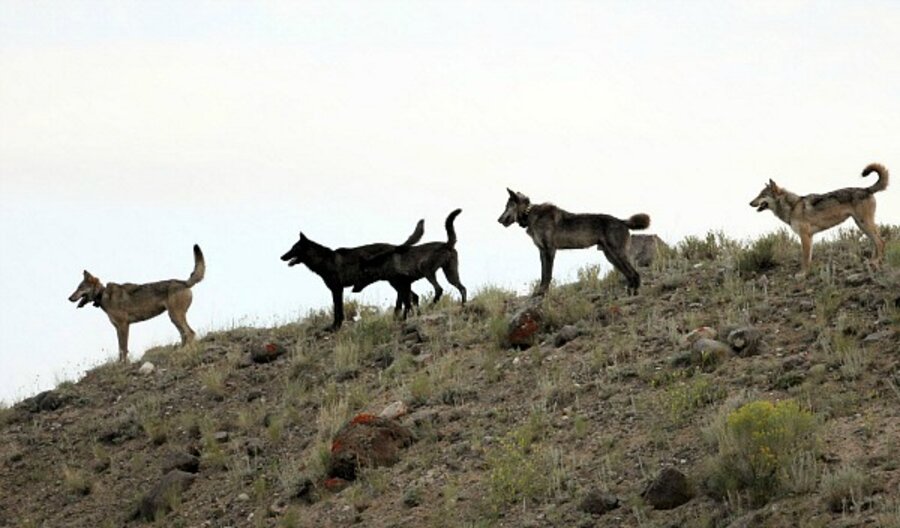No-kill wolf ban spurs nonlethal options
Loading...
| GRANTS PASS, Ore.
As long as wolves have been making their comeback, biologists and ranchers have had a decidedly Old West option for dealing with those that develop a taste for beef: Shoot to kill. But for the past year, Oregon has been a "wolf-safe" zone, with ranchers turning to more modern, nonlethal ways to protect livestock.
While the number of wolves roaming the state has gone up, livestock kills haven't — and now conservation groups are hoping Oregon can serve as a model for other Western states working to return the predator to the wild.
"Once the easy option of killing wolves is taken off the table, we've seen reluctant but responsible ranchers stepping up," said Rob Klavins of the advocacy group Oregon Wild. "Conflict is going down. And wolf recovery has got back on track."
The no-kill ban has been in place since September 2011. That's when the Oregon Department of Fish and Wildlife announced it planned to kill two members of the Imnaha wolf pack in northeastern Wallowa County for taking livestock. Conservation groups sued, arguing that rules allowing wolves to be killed to reduce livestock attacks did not comply with the state Endangered Species Act. The Oregon Court of Appeals stepped in, prohibiting wolf kills while the two sides work to settle, although ranchers who catch wolves in the act of killing livestock may still shoot them.
At the end of 2012, wolf numbers in the state had risen to 46 from 29 in 2011, according to state fish and wildlife officials. Meantime, four cows and eight sheep were killed last year by two separate packs, while 13 cows were killed by one pack in 2011.
Wallowa County cattle rancher Karl Patton started giving nonlethal methods a try in 2010, after he fired off his pistol to chase off a pack of wolves in a pasture filled with cows and newborn calves. State wildlife officials provided him with an alarm that erupts with bright lights and the sound of gunshots when a wolf bearing a radio-tracking collar treads near. He also staked out fladry fencing at calving time. The long strings of red plastic flags flutter in the wind to scare away wolves. The flags fly from an electrically charged wire that gives off a jolt to predators that dare touch it.
The rancher put 7,000 miles on his ATV spending more time with his herd, and cleaned up old carcasses that put the scent of meat on the wind. And state wildlife officials text him nightly, advising whether a wolf with a satellite GPS tracking collar is nearby.
"None of this stuff is a sure cure," said Patton, who worries the fladry will lose its effectiveness once wolves become accustomed to it. Such measures also can't be used in open range.
Seen as a scourge on the landscape, wolves were nearly wiped out across the Lower 48 by the 1930s. In 1995, the federal government sponsored the reintroduction of wolves into Yellowstone National Park and central Idaho. They eventually spread to Montana, Wyoming, Oregon, Washington and California.
With wolf numbers approaching 1,800, the federal government dropped Endangered Species Act protection in 2011 in the Northern Rockies, eastern Oregon and eastern Washington, and turned over recovery management to the states.
While ranchers are not happy with the wolf comeback, the wider public is. A 2011 survey for the Washington Department of Fish and Wildlife found 74.5 percent of Washington residents believe it acceptable for wolves to recolonize their state.
Wolf advocates hope the Oregon experiment can spread elsewhere, especially Idaho, which had 746 wolves in 2011. In 2012, hunters and wildlife agents killed 422 wolves, compared with 296 for 2011. Sheep and cattle kills, meantime, went up from 192 in 2011 to 341 in 2012.
Idaho Fish and Game biologist Craig White said it "raised eyebrows" on both sides of the wolf debate when the livestock kills rose even as more wolves were killed. Previously the trend had been for livestock kills to go down as wolf kills went up. The state plans to continue killing wolves until elk herds — their primary prey and a popular game animal — start increasing, he said.
The Idaho numbers show "you can't manage wolves using conventional wisdom and assumption," said Suzanne Stone of Defenders of Wildlife in Idaho. "Using these old archaic methods of managing predators by just killing them is not working."
In "no-kill" Oregon, ranchers disagree. Wallowa rancher Dennis Sheehy puts bells on his cattle to help scare away wolves. He also spends more time with his herd, and cleans up old bone piles. Nevertheless, he believes a kill option should always be on the table for wolves that prey on livestock. The 2011 ban, he said, "really upset people around here."
Patton has never lost a cow while using the fladry and alarms. But two were killed on the open range and one in a large pasture where such protection measures are impractical. He has also found tracks showing wolves crossed the fladry and walked among his cows without, for some reason, attacking them.
He still believes the only way to deal with wolves that attack cattle is to kill the whole pack.
"It's frustrating, more than anything, because we have our hands tied," he said. "You can kill a man [who] comes into your house to rob you. Wolves are more protected than people."







